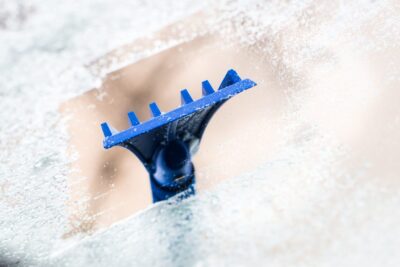Ten popular ways to de-ice your windscreen
Ten of the most common methods used to combat the problem of frozen windscreens on cold winter mornings.
1. Boiling Water – Most car windscreens are made from laminated glass which is made up of 2 layers of glass with a layer of PolyVinyl Butyral (PVB) sandwiched between them. The 3 layers are bonded together under heat and pressure to produce a single unit glass windscreen. The middle plastic layer of the windshield gives the glass its strength and holds the inner and outer glass layers together. When a windscreen freezes the water on the outside of the glass causes the glass itself to become very cold. If hot water is poured on a freezing cold windscreen the sudden change in temperature can cause the 3 bonded layers to expand at different rates and crack.
2. CD or CD case – These can scratch a windscreen and are not advisable to use, they will also ruin the CD.
3. Credit/debit card – Again these can scratch the windscreen and damage the credit card in the process. Although the plastic of the card is too soft to scratch the glass by itself, bits of abrasive debris can get caught in the edge of the card which when used to clear ice from a windscreen can scratch the glass.
4. Pen knife – Knives are used for graffiti scratching/etching by graffiti artists as they like to call themselves, who scratch permanent messages into glass such as bus windows, trains, shop windows etc. Next time you decide to de-ice your windscreen with a knife, consider the damage you may cause and how much it may end up costing you.
5. Heated ice scrapers – Rechargeable cordless ice scrapers last for around 15 to 20 minutes per charge and can take up to 7 hours to recharge. The downside is that many users complain they take too long to heat up and by the time they are ready to use you could have cleared the windscreen with a conventional ice scraper. If you do have one then plan ahead and turn it on a few minutes before leaving the house so it should be ready to use when you need it.
6. De-icer spray – Works by lowering the freezing point of water so that it melts to a liquid. Ethylene glycol is often used in anti-freeze which acts much like rock salt but is more environmentally friendly and purer, so less is needed. It’s also in a liquid format, so has the advantage of being able to seep between the small cracks found in ice to melt the ice quicker. Ethylene glycol is less harmful to your cars bodywork than salt, but is very toxic and can be adsorbed through your skin. The chemical industry claim that small levels of exposure to this chemical are harmless, whereas high levels of exposure can cause serious irreversible damage.
7. Plastic Ice scraper – The conventional way for removing ice from your windscreen. Invest in a good quality ice scraper which will only cost a few pounds more but will likely be more efficient at removing ice and last longer as cheap plastic scrapers tend to easily snap.
8. Windscreen Cover – These are plastic covers that are available for just the front windscreen, front and back or the entire car and can work very well. Some covers have suckers on them to keep them in place and two side tab sections which enclose inside the passenger and driver doors to secure them and prevent them from being stolen.
9. Pre-Ice spray – There are a number of products on the market that get sprayed on the windscreen in the evening to get a frost free windscreen the following morning.
Halfords Night Before spray prevents frost from sticking to the windscreen so that any ice build up can be easily wiped off in the morning. Other products such as Magic Ice stop and Rain X Anti Ice are said to give frost fee windscreens when applied the night before.
10. Car heater – Leaving the house 10 -15 minutes early to let the heater clear your windscreen is not very environmentally friendly. If your car is parked in the street and you leave it running idle you need to stay with your vehicle or it will likely attract attention and may not be there when you return.
As an alternative there are standalone heaters on the market that sit on the dashboard and are specifically designed for defrosting windscreens. They come with 24 hour clocks so that they can be set to start defrosting the windscreen 30 minutes or so before you leave the house in the morning, so that the windscreen will be frost free when you are ready to drive.


 Driving in France
Driving in France